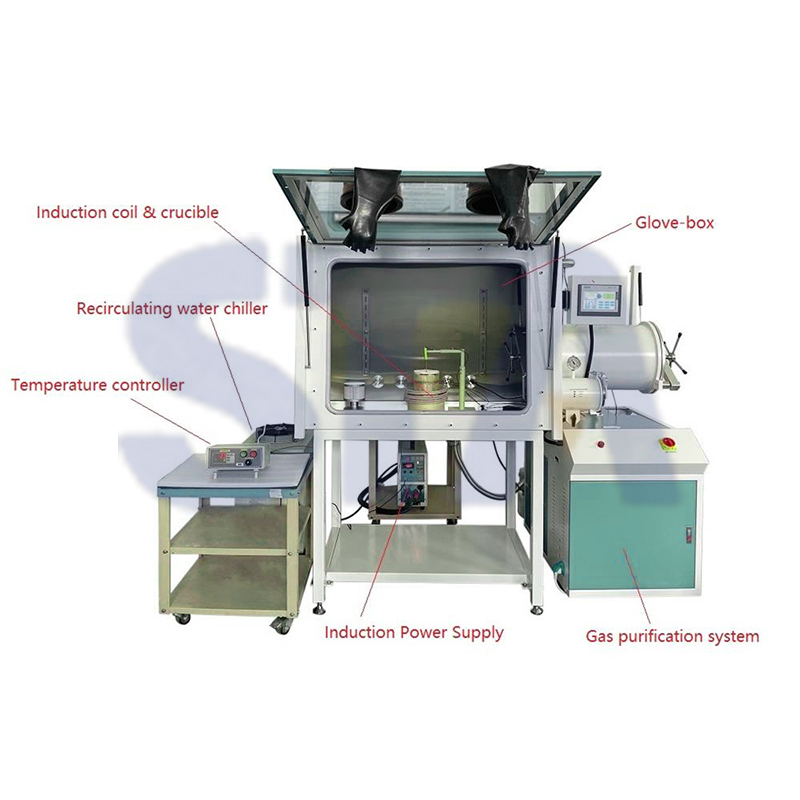This Induction Melting System in Glovebox with Gas Purification ( 1PPM ) aims to provide an ultra-pure environment for high-precision melting applications, significantly impacting industries such as semiconductor manufacturing, advanced materials research, and pharmaceutical production.
Key Features and Benefits:
Precision Gas Purification: The system incorporates a gas purification mechanism that ensures the environment is free from contaminants, ideal for ultra-pure applications where even trace amounts of impurities can affect the outcome.
Advanced Induction Technology: Utilizing cutting-edge induction technology, the system offers rapid and uniform melting, enhancing the efficiency and consistency of the melting process.
Glovebox Integration: Designed to be compatible with existing glovebox setups, the system facilitates easy integration and operation within these specialized environments.
Energy Efficiency: Optimized for energy usage, the system helps reduce operational costs while maintaining high performance and reliability.
User-Friendly Interface: An intuitive user interface enables real-time monitoring and control, ensuring operators can manage the system with ease and confidence.
Industry Impact:
The introduction of this Induction Melting System with Gas Purification represents a significant advancement in the field of high-purity materials processing. It addresses the growing demand for ultra-clean environments in sectors such as semiconductor fabrication, where even trace amounts of impurities can impact product quality and yield.
Since its deployment, several leading semiconductor manufacturers have reported a notable improvement in the purity of their silicon wafers, leading to higher yields and enhanced product performance. One company, after integrating the system into its production line, saw a significant reduction in defects associated with contamination, demonstrating the potential for widespread adoption across the industry.
Case Study: Semiconductor Industry Application
The semiconductor manufacturer, after adopting the Induction Melting System with Gas Purification in its production line, has experienced a substantial improvement in the purity of its silicon wafers. This has led to higher yields and better product performance, showcasing the system's capability to meet the stringent requirements of the semiconductor market.

Applications and Integration of Induction Melting Systems with Gas Purification (1 PPM) in Industry
Induction melting systems equipped with gas purification capabilities that achieve 1 part per million (PPM) purity levels are essential in various high-precision manufacturing processes. These systems are particularly beneficial when used in conjunction with gloveboxes, which provide a controlled environment free from contaminants. Here’s how they can be applied in different scenarios and integrated with other machinery:
1. Semiconductor Manufacturing:
In semiconductor manufacturing, the purity of materials is critical to ensure the quality and functionality of electronic devices. An induction melting system within a glovebox can help maintain the required purity levels by minimizing exposure to ambient air. This setup can be integrated with vacuum pumps and gas delivery systems to create an inert atmosphere, ensuring that the molten material remains free from impurities during the entire melting and casting process.
2. Pharmaceuticals and Biotechnology:
In pharmaceutical and biotechnology applications, where the synthesis of active pharmaceutical ingredients (APIs) requires high purity, the induction melting system can be crucial. It can be used in combination with gloveboxes to prevent oxidation and contamination, ensuring that the chemical reactions proceed under strictly controlled conditions. This is especially important for sensitive compounds that degrade easily or react with moisture and oxygen.
3. Advanced Materials Research:
Researchers working on advanced materials, such as alloys and composites, often require extremely pure substances to study their properties accurately. An induction melting system within a glovebox with gas purification can facilitate the creation of such materials by providing a clean environment for melting and alloying processes. This system can be connected to analytical instruments for real-time monitoring of the melting process and the purity of the materials being processed.
4. Metallurgy and Metal Refining:
For metallurgical applications, such as refining precious metals or producing specialty alloys, an induction melting system in a glovebox ensures that the final product meets stringent purity requirements. The gas purification system keeps the environment free from reactive gases, preventing the formation of oxides or other impurities that could compromise the metal’s integrity. This setup can be linked with casting machines and rolling mills to form a complete production line.
5. Nanotechnology:
In nanotechnology, the synthesis of nanoparticles and nanomaterials demands an ultra-clean environment to prevent agglomeration and contamination. Using an induction melting system in a glovebox allows for the precise control of temperature and atmosphere, enabling the production of high-quality nanoparticles. This can be combined with specialized reactors and centrifuges to achieve the desired particle size and distribution.
Integration with Other Equipment
To enhance the effectiveness of the induction melting system, it can be integrated with other specialized equipment such as:
Vacuum Systems: To remove air and achieve a vacuum environment before introducing inert gases.
Gas Delivery Systems: For supplying inert gases like argon or nitrogen to maintain the desired atmosphere within the glovebox.
Analytical Instruments: Such as mass spectrometers or optical emission spectrometers to monitor the composition and purity of the materials.
Automation Systems: Including robotic arms and automated material handling systems to reduce human intervention and maintain sterility.
Environmental Monitoring Devices: To continuously check for particulate matter, humidity, and other environmental factors that could affect the process.
By combining the induction melting system with these additional pieces of equipment, industries can achieve a high level of automation and control, resulting in superior product quality and increased efficiency.
Working Principle: 1.Induction Heating Mechanism: The Induction Melting System utilizes the principle of electromagnetic induction to generate heat. When alternating current flows through an induction coil, it produces a changing magnetic field. Conductive materials (such as metals) placed inside the coil experience eddy currents due to the magnetic field, and the resistance heating from these currents melts the material.
2. Glovebox Environment Control: A glovebox is a sealed workspace equipped with a gas purification system capable of controlling the internal atmosphere. The gas purification system typically includes filters and regeneration units that remove moisture, oxygen, and other contaminants, creating an environment predominantly filled with inert gases like argon or nitrogen.
3. Gas Purification Process: Initially, a vacuum pump evacuates the original gas from the glovebox to achieve a certain vacuum level. Once the vacuum is established, purified inert gas is introduced into the glovebox. The gas purification unit ensures that the concentration of impurities is reduced to below 1 part per million (ppm), guaranteeing that the melting process occurs in a highly pure environment.
4. Melting and Casting: After the material is heated to its melting point inside the induction coil within the glovebox, the melting operation can commence. Post-melting, the molten metal can be cast or processed further, all within the protected environment, ensuring the entire process remains under controlled conditions.
Usage Considerations: 1.Safety Precautions: Ensure all safety measures are in place before operating the system, including wearing appropriate personal protective equipment (PPE) such as heat-resistant gloves and face shields. Follow the safety guidelines provided by the manufacturer.
2. Environment Control: Regularly inspect the glovebox seal and the efficacy of the gas purification system to ensure the internal atmosphere meets the required standards. If leaks are detected or if the gas purity drops, immediately halt operations and conduct repairs. 3.Maintenance and Servicing: Perform routine maintenance on critical components such as the induction coil, cooling system, and other parts to prevent operational failures due to wear and tear. Replace filters and consumables regularly to maintain the effectiveness of the gas purification process.
3. Operator Training: All operators should undergo professional training to understand the system's operation principles, procedures, and emergency response protocols. Unauthorized personnel should not operate the equipment.
4. Monitoring and Record Keeping: During the melting process, use accompanying monitoring equipment to track parameters such as temperature and gas composition in real-time. Record data for quality control and troubleshooting purposes.
6.Emergency Planning: Develop and familiarize yourself with an emergency response plan that covers actions to take in case of fire, gas leaks, or other emergencies. Ensure that in the event of an incident, swift and effective action can be taken. By adhering to these precautions, operators can ensure that the Induction Melting System in a Glovebox with Gas Purification operates safely and efficiently, achieving the desired high-purity melting results.
Future Prospects:
As industries continue to evolve and demand ever-higher standards of purity, the Induction Melting System with Gas Purification is poised to become an indispensable tool for companies striving to deliver the highest quality products. The system's ability to achieve and maintain ultra-pure conditions is expected to drive further innovations and set new benchmarks in materials processing.
Related product recommendations
Muffle furnace: A high-temperature heating device commonly used for heat treatment and material analysis.
Vacuum furnace: An equipment that creates a low-pressure environment for specialized material processing.
Tube furnace: A furnace designed for heating samples within a tube-shaped chamber.
Dental furnace: Specifically designed for dental procedures like sintering dental materials.
Crucible furnace: Used for melting and heating materials placed in a crucible.
Bogie Hearth Furnace :The bogie hearth furnace is a type of industrial furnace with a movable hearth on which materials can be placed for heating and processing.
Atmosphere Furnace:A furnace that can create and control a specific atmosphere (such as argon, nitrogen, etc.) inside for the heat treatment of materials to achieve better processing results.
